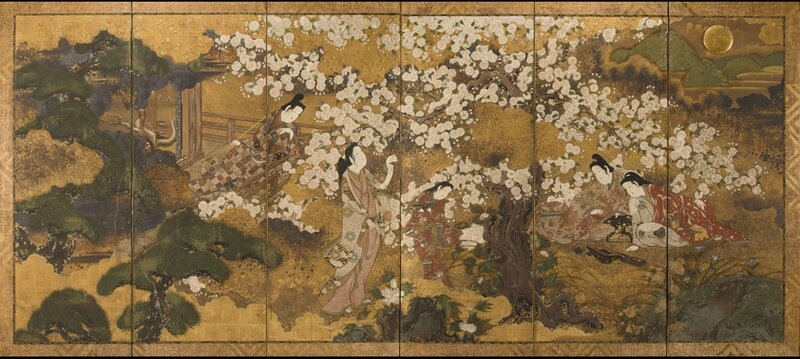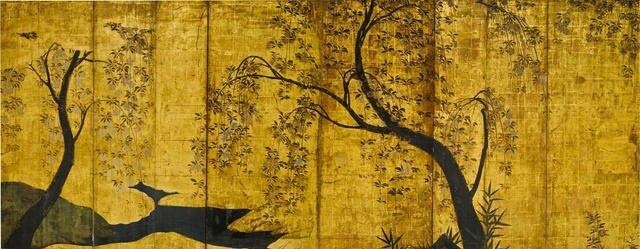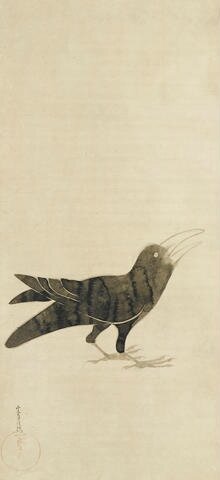Spectacular variety of elegantly painted Japanese screens unfold at Bonhams New York
NEW YORK – The Fine Japanese Works of Art sale on March 19 at Bonhams will feature a variety of elegantly painted screens. The iconic art form, which is both decorative and functional, has been extant in Japan since the 8th century.
A splendid example from the circle of Iwasa Matabei serves as a window to 17th century Japanese culture (est. $100,000-150,000). The six-panel folding screen, embellished with colours, ink, and gold and silver foil, shows fashionable young men and their beautiful female companions enjoying a cherry tree in full bloom in a garden. Iwasa Matabei (1578-1650) has been credited with taking genre painting in a new direction, by concentrating on larger figures engaged in pursuits of pleasure and leisure – the manner of painting here is typical of what came to be known as the Matabei style.
Circle of Iwasa Matabei (17th century) Composing Poetry in a Spring Landscape. Est. $100,000-150,000. Photo: Courtesy of Bonhams.
A large six-panel screen, ink, color, silver and gold pigment on paper applied with silver and gold foil, gilt metal disk; depicting elegant youths and beauties watching their companion hang a tanzaku poem card on a flowering cherry tree, the blossoms rendered inmoriage and a large gilt metal sun to the far right; unsigned; 67 7/8 x 144 1/2in (167.4 x 367cm). Estimate US$ 100,000 - 150,000 (€72,000 - 110,000)
Iwasa Matabei (1578-1650) has been credited with taking genre painting in a new direction - concentrating on larger figures engaged in pursuits of pleasure and leisure, largely devoid of geographical context.
This spectacular screen shows fashionable young men and their beautiful female companions enjoying a cherry tree in full bloom in a garden. A stylishly-dressed young man reclining on a veranda, holds a long pipe as he gazes upon a gorgeously-clad woman hanging a freshly written poem card from a branch of the tree. Her attendant holds the lacquer tray with the writing brush and ink. Another attractive couple at the right lean on an armrest, and contemplate what to write, the writing set laid out before them.
The emphasis here seems to be on the figures and the activity rather than on the surroundings. The artist has paid specific attention to the contemporary styles, (taking great care to show the unique patterns of each character's robe), and the current fashion trends (the inclusion of the impossibly long pipe suggests the rage for tobacco, recently introduced by the Portuguese around 1601). The figures are large in comparison to the composition.
The painting here is typical of what came to be known as the Matabei style. The figures' faces are somewhat pear-shaped with wide jaws and narrow foreheads and the bodies are supple and long yet corpulent. The cherry blossoms rendered in bold relief (moriage) with subtle gold highlights create a sense of depth and three dimensionality. The lavish gold clouds are also enhanced with geometric shapes raised in moriagetechnique. Extensive use of gold and silver flecks further add to the luxurious atmosphere.
The origins of tanzaku poem cards may be in divination papers used in ancient times or perhaps related to the small rectangular papers that were used in poetry gatherings in the Heian period. The custom of hangingtanzaku from cherry trees became a popular motif in ukiyo-e prints and paintings.
A large six panel screen, ink, color and gold on paper, ofnagare-zakura along a stream, the blossoms defined inmoriage; unsigned;65 x 148 1/2in (165.2 x 377.4cm). Estimate US$ 15,000 - 20,000 (€11,000 - 14,000)
Provenance: purchased Yabumoto Shoichi, 1977.
Ex collection Ogiwara Yasunosuke, Tokyo
Exhibited: Kochukyo galleries, 1955
Published: Yamane Yuzo, Sotatsu, Nihon keizai shinbun publishers, 1962, plate 112
Other treasures can be found throughout the March 19 sale, which showcases more than 350 fine Japanese pieces, including bronzes, ceramics, woodblock prints, lacquer works, and even Samurai armour. A notable highlight is a large Imperial presentation silver bowl by Hirata Shigemitsu VII (est. $30,000-40,000). This impressive bowl was a commission by the Imperial Household of the Taisho Emperor as a gift for Baron Komura Jutaro. Rounding out the fine selection of Meiji period works are two private collections of cloisonné enamel, metalwork and Satsuma wares.
Provenance: Baron Komura Jutaro (1855-1911), and thence by descent
The Fine Japanese Works of Art sale will take place on March 19 at Bonhams New York. The sale will preview at Bonhams March 14-19.

/https%3A%2F%2Fprofilepics.canalblog.com%2Fprofilepics%2F1%2F0%2F100183.jpg)
/https%3A%2F%2Fstorage.canalblog.com%2F03%2F02%2F119589%2F96711876_o.jpg)
/https%3A%2F%2Fstorage.canalblog.com%2F11%2F31%2F119589%2F94773502_o.jpg)
/https%3A%2F%2Fstorage.canalblog.com%2F20%2F83%2F119589%2F94772815_o.jpg)
/https%3A%2F%2Fstorage.canalblog.com%2F26%2F72%2F119589%2F75604929_o.jpg)
/https%3A%2F%2Fstorage.canalblog.com%2F59%2F60%2F119589%2F26458628_o.jpg)






/http%3A%2F%2Fstorage.canalblog.com%2F32%2F99%2F119589%2F129836631_o.jpg)
/http%3A%2F%2Fstorage.canalblog.com%2F46%2F82%2F119589%2F129704536_o.jpg)
/http%3A%2F%2Fstorage.canalblog.com%2F49%2F48%2F119589%2F129680938_o.jpg)
/http%3A%2F%2Fstorage.canalblog.com%2F64%2F83%2F119589%2F129635530_o.jpg)